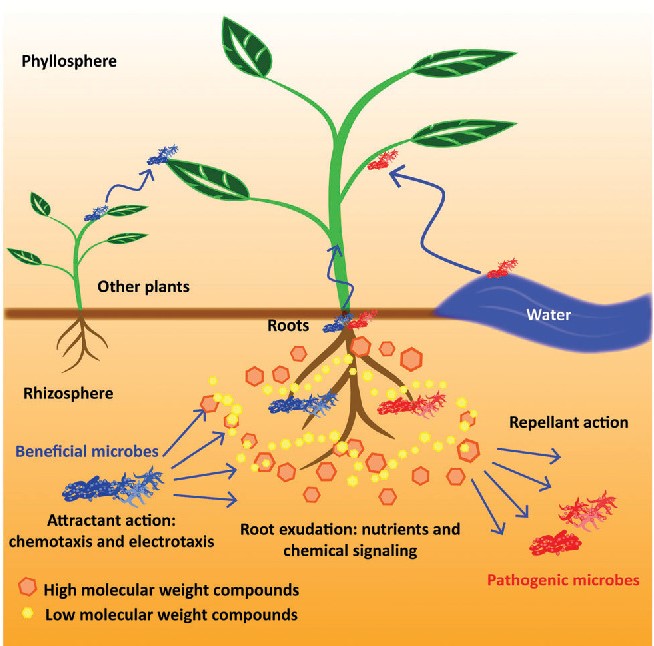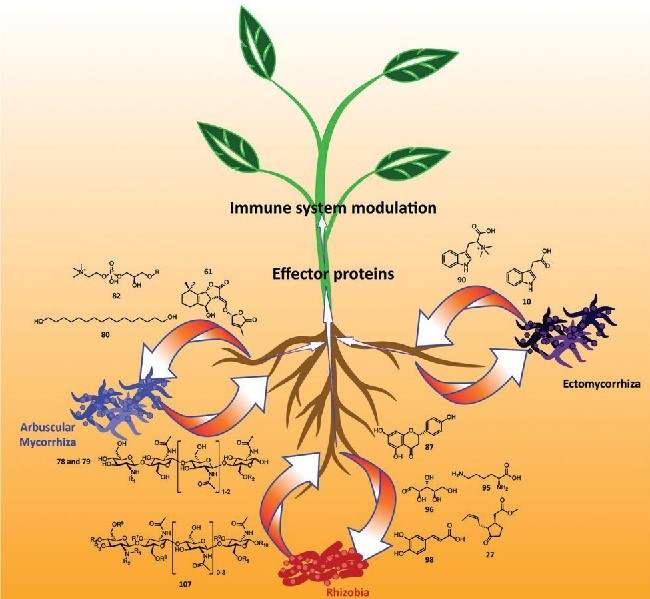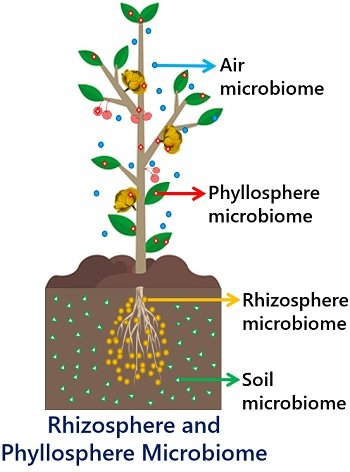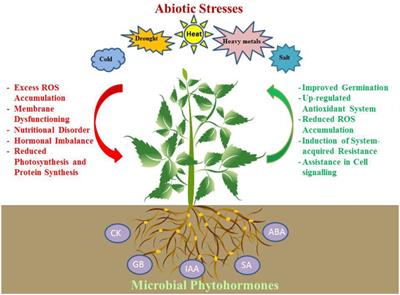Contents [show]
A novel approach to enhance the productivity and resilience of crops using natural and eco-friendly biostimulants
Prof. Aécio D’Silva, Ph.D
AquaUniversity
Phytohormones and Beneficial Microbes – Sustainable agriculture is the practice of producing food, fiber, and fuel in a way that meets the needs of the present without compromising the ability of future generations to meet their own needs. Sustainable agriculture aims to conserve natural resources, protect the environment, enhance human health, and ensure social and economic well-being. However, sustainable agriculture faces many challenges, such as climate change, population growth, land degradation, water scarcity, pest and disease outbreaks, and food insecurity. To overcome these challenges, farmers need to adopt innovative and efficient methods of crop management that can increase the yield and quality of crops, while reducing the input and impact of synthetic chemicals, such as fertilizers, pesticides, and growth regulators. One of the possible solutions is to use phytohormones and beneficial microbes, which are natural and eco-friendly biostimulants that can improve the growth and development of plants by modulating their physiological and biochemical processes. [1]
What are phytohormones and beneficial microbes and how do they work?
Phytohormones are organic compounds that are produced by plants or microorganisms and act as signaling molecules that regulate various aspects of plant growth and development, such as cell division, differentiation, elongation, flowering, fruiting, senescence, and stress response. Phytohormones can be classified into different groups, such as auxins, cytokinins, gibberellins, ethylene, abscisic acid, brassinosteroids, jasmonates, and salicylic acid. Each group of phytohormones has a specific function and mode of action, but they can also interact with each other to modulate their effects.
Beneficial microbes are microorganisms that live in association with plants and provide benefits to their hosts, such as enhancing nutrient uptake, improving soil health, inducing plant immunity, and suppressing plant pathogens. Beneficial microbes can be divided into two main categories: plant growth-promoting rhizobacteria (PGPR) and arbuscular mycorrhizal fungi (AMF). PGPR are bacteria that colonize the root surface or the rhizosphere (the soil zone influenced by the root) and produce phytohormones, enzymes, siderophores, antibiotics, and volatile organic compounds that can stimulate plant growth and protect plants from biotic and abiotic stresses. AMF are fungi that form symbiotic relationships with the roots of most plants and form a network of hyphae (fungal filaments) that extend beyond the root system and increase the surface area for nutrient and water absorption, as well as transfer phytohormones and other metabolites between the plant and the fungus.
The combination of phytohormones and beneficial microbes can create a synergistic effect that can enhance the performance and resilience of crops, by influencing various aspects of plant physiology and metabolism, such as: [2]
- Nutrient acquisition: Phytohormones and beneficial microbes can increase the availability and uptake of essential nutrients, such as nitrogen, phosphorus, potassium, iron, and zinc, by altering the root morphology, architecture, and exudation, as well as solubilizing, chelating, or fixing the nutrients in the soil. For example, auxins can stimulate root growth and branching, cytokinins can increase root hair formation and density, gibberellins can enhance root elongation and depth, and ethylene can induce root swelling and nodulation. PGPR can produce enzymes, such as phosphatases, ureases, and nitrogenases, that can hydrolyze or fix the organic or inorganic forms of nutrients, and siderophores, that can bind and transport iron. AMF can extend the root system increase the contact area with the soil, and also exchange nutrients with the plant through the arbuscules (specialized structures formed inside the root cells). [3]
- Stress tolerance: Phytohormones and beneficial microbes can improve the resistance and adaptation of plants to various abiotic and biotic stresses, such as drought, salinity, temperature, heavy metals, and pathogens, by modulating the expression and activity of genes, enzymes, and metabolites involved in the stress response. For example, abscisic acid can induce stomatal closure and osmotic adjustment, jasmonates can activate the synthesis of antioxidants and defense proteins, salicylic acid can trigger the systemic acquired resistance and the hypersensitive response, and brassinosteroids can enhance the membrane stability and the detoxification of reactive oxygen species. PGPR can produce phytohormones, such as abscisic acid, jasmonates, and salicylic acid, that can mimic or amplify the plant stress response, and also produce volatile organic compounds, such as acetoin, dimethyl disulfide, and 2,3-butanediol, that can mitigate the oxidative damage and modulate the gene expression of the plant. AMF can improve the water and nutrient status of the plant, and also produce phytohormones, such as abscisic acid, jasmonates, and salicylic acid, that can regulate the plant stress response, and also induce the expression of genes related to the pathogenesis-related proteins and the phenylpropanoid pathway. [1]
- Growth promotion: Phytohormones and beneficial microbes can stimulate the growth and development of plants by enhancing the photosynthesis, respiration, transpiration, and biomass production, as well as the flowering, fruiting, and seed formation, by regulating the synthesis and activity of various molecules and pathways involved in these processes. For example, auxins can promote cell elongation and expansion, cytokinins can promote cell division and differentiation, gibberellins can promote stem elongation and seed germination, and ethylene can promote fruit ripening and senescence. PGPR can produce phytohormones, such as auxins, cytokinins, and gibberellins, that can modulate plant growth and development, and also produce enzymes, such as 1-aminocyclopropane-1-carboxylate (ACC) deaminase, that can lower the ethylene level and prevent the ethylene-induced growth inhibition. AMF can increase the photosynthetic rate and the chlorophyll content of the plant and also produce phytohormones, such as auxins, cytokinins, and gibberellins, that can regulate plant growth and development. [1
What are the challenges and prospects of using phytohormones and beneficial microbes for sustainable agriculture?
Phytohormones and beneficial microbes are natural and eco-friendly biostimulants that can improve the growth and development of plants by modulating their physiological and biochemical processes. Many crops can benefit from phytohormones and beneficial microbes, especially those that are grown under stressful conditions, such as drought, salinity, temperature, nutrient deficiency, or pest and disease attack. Some challenges that must be considered when applying phytohormones and beneficial microbes are:
- Optimization: The optimal type, concentration, combination, and timing of phytohormone and beneficial microbe application may vary depending on the crop species, variety, and cultivation conditions. Therefore, it is necessary to conduct systematic and comprehensive experiments to determine the best phytohormone and beneficial microbe treatment for each crop system.
- Cost-effectiveness: The cost and availability of phytohormones and beneficial microbes may affect the economic feasibility and scalability of using phytohormones and beneficial microbes for sustainable agriculture. Therefore, it is important to develop low-cost and high-efficiency methods of producing and applying phytohormones and beneficial microbes, such as using biotechnology or nanotechnology.
- Environmental impact: The use of phytohormones and beneficial microbes may have some negative effects on the environment, such as causing phytohormone and microbial pollution, altering the natural balance of phytohormones and microbes, and affecting the biodiversity and ecology of soil and plant ecosystems. Therefore, it is essential to evaluate the environmental safety and sustainability of using phytohormones and beneficial microbes for sustainable agriculture.
Despite these challenges, using phytohormones and beneficial microbes for sustainable agriculture has great potential and prospects, as it can:
- Enhance the productivity and resilience of crop systems, by increasing the yield and quality of crops, improving stress tolerance and stability, and optimizing the growth and development of plants.
- Complement and synergize with other methods of improving sustainable agriculture, such as organic farming, precision agriculture, and integrated pest management, by providing additional or alternative ways of managing crop nutrition, health, and growth.
- Contribute to the development and innovation of agricultural biotechnology, by providing new insights and opportunities for understanding and manipulating the molecular and cellular mechanisms of plant-microbe interactions and phytohormone signaling. [2, 3]
What are some examples of crops that can benefit from phytohormones and beneficial microbes?
Phytohormones and beneficial microbes are natural and eco-friendly biostimulants that can improve the growth and development of plants by modulating their physiological and biochemical processes. Many crops can benefit from phytohormones and beneficial microbes, especially those that are grown under stressful conditions, such as drought, salinity, temperature, nutrient deficiency, or pest and disease attack. Some examples of crops that can benefit from phytohormones and beneficial microbes are:
- Cereals: Wheat, rice, maize, barley, sorghum, and millet are some of the most important cereal crops that provide food and feed for humans and animals. Phytohormones and beneficial microbes can increase the yield and quality of cereals by enhancing their nutrient uptake, photosynthesis, stress tolerance, and disease resistance. For example, auxins, cytokinins, and gibberellins can promote the grain filling and seed germination of cereals. [2]
PGPR and AMF can increase the nitrogen and phosphorus availability and uptake of cereals. [4, 5]
- Legumes: Soybeans, peanuts, chickpeas, alfalfa lentils, peas, and beans are some of the major legume crops that are rich in protein and/or oil. Phytohormones and beneficial microbes can improve the growth and productivity of legumes by stimulating their root nodulation, nitrogen fixation, and seed formation. For example, auxins, cytokinins, and ethylene can regulate the symbiotic interaction between legumes and rhizobia, which are bacteria that can fix atmospheric nitrogen in the root nodules of legumes. [10] PGPR and AMF can also enhance the nodulation and nitrogen fixation of legumes. [7]
- Oilseeds: Sunflower, rapeseed, canola, safflower, and sesame are some of the important oilseed crops that produce edible and industrial oils. Phytohormones and beneficial microbes can boost the oil yield and quality of oilseeds by increasing their biomass, flowering, and seed oil content. For example, auxins, cytokinins, and gibberellins can increase the number and size of flowers and seeds of oilseeds. PGPR and AMF can increase the oil content and fatty acid composition of oilseeds.

- Fruits: Apple, banana, grape, citrus, mango, and strawberry are some of the popular fruit crops that are consumed fresh or processed. Phytohormones and beneficial microbes can enhance fruit yield and quality by affecting their flowering, fruit set, fruit development, and fruit ripening. For example, auxins, cytokinins, and gibberellins can increase the fruit set and size. Ethylene can induce the fruit ripening and color development of fruits. PGPR and AMF can improve the fruit quality and shelf life of fruits.
- Vegetables: Tomato, potato, onion, carrot, cabbage, and lettuce are some of the common vegetable crops that are consumed raw or cooked. Phytohormones and beneficial microbes can improve vegetable yield and quality by influencing their vegetative growth, tuber formation, bulb development, and leaf production. For example, auxins, cytokinins, and gibberellins can increase the tuber and bulb yield and quality of potato and onion. Ethylene can increase the leaf senescence and abscission of lettuce. PGPR and AMF can increase the biomass and nutrient content of vegetables.
These are just some of the examples of crops that can benefit from phytohormones and beneficial microbes. There are many more crops that can be improved by using these natural and eco-friendly biostimulants, which can help to achieve sustainable agriculture. [2, 4]
How do auxins, cytokinins, and gibberellins work on plants?
These are three groups of phytohormones, which are natural or synthetic compounds that regulate the growth and development of plants. Here is a summary of their functions and effects:
- Auxins are mainly produced in the shoot apical meristem, the growing tip of the stem, and are transported to other parts of the plant. Auxins can promote cell elongation and expansion, root growth and branching, apical dominance (the suppression of lateral buds by the main stem), and fruit development. Auxins can also influence the phototropism (the bending of the plant towards light) and gravitropism (the bending of the plant in response to gravity) of the plant, by causing differential growth of the cells on the opposite sides of the stem or root. [8]
- Cytokinins are mainly produced in the root apical meristem, the growing tip of the root, and are transported to other parts of the plant. Cytokinins can promote cell division and differentiation, shoot growth and branching, leaf development and senescence (the aging and death of the leaf), and chlorophyll synthesis. Cytokinins can also influence the balance between root and shoot growth, by counteracting the effect of auxins. For example, a high ratio of cytokinins to auxins can stimulate the growth of lateral buds, while a low ratio can inhibit it. [8]
- Gibberellins are produced in various tissues of the plant, such as the young leaves, seeds, and flowers, and are transported to other parts of the plant. Gibberellins can promote stem elongation and thickness, seed germination and dormancy, flower initiation and development, and fruit growth and ripening. Gibberellins can also influence the plant’s response to environmental factors, such as light, temperature, and day length. For example, gibberellins can induce the flowering of long-day plants (plants that flower when the day length is longer than a critical period) under short-day conditions. [8]
These are some of the main functions and effects of auxins, cytokinins, and gibberellins on plants. However, these phytohormones do not act in isolation, but interact with each other and with other phytohormones, such as ethylene, abscisic acid, and brassinosteroids, to modulate their effects. The response of the plant to phytohormones depends on the type, concentration, and combination of phytohormones, as well as the developmental stage and physiological condition of the plant [9]
How do phytohormones interact with beneficial microbes in plants?
Phytohormones are natural or synthetic compounds that regulate the growth and development of plants. Beneficial microbes are microorganisms that live in association with plants and provide benefits to their hosts, such as enhancing nutrient uptake, improving soil health, inducing plant immunity, and suppressing plant pathogens. Phytohormones and beneficial microbes interact with each other in various ways, such as:
- Phytohormones can influence the colonization and activity of beneficial microbes on the plant surface or in the plant tissues, by altering the root morphology, exudation, and signaling, as well as the plant immune system. [2, 4]
For example, auxins can promote root colonization and nodulation by rhizobia, which are bacteria that can fix atmospheric nitrogen in the root nodules of legumes. [10]
Cytokinins can modulate the symbiotic interaction between plants and arbuscular mycorrhizal fungi (AMF), which are fungi that form a network of hyphae that extend beyond the root system and increase the surface area for nutrient and water absorption. [17]
- Beneficial microbes can produce phytohormones or modulate the endogenous levels and balance of phytohormones in plants, by synthesizing, degrading, or transporting phytohormones, or by affecting the expression and activity of phytohormone biosynthetic and signaling genes and enzymes. [2, 4]
For example, plant growth-promoting rhizobacteria (PGPR) can produce auxins, cytokinins, and gibberellins, which can stimulate plant growth and development. AMF can produce abscisic acid, jasmonates, and salicylic acid, which can regulate plant stress response. [2]
The interaction between phytohormones and beneficial microbes can create a synergistic effect that can enhance the performance and resilience of plants, by influencing various aspects of plant physiology and metabolism, such as nutrient acquisition, stress tolerance, and growth promotion. [2, 4]
Example of a large-scale application of phytohormones and beneficial microbes?
One of the examples is the use of phytohormones and beneficial microbes to enhance the growth and yield of rice, which is one of the most important cereal crops in the world. Rice is often grown under stressful conditions, such as drought, salinity, nutrient deficiency, and pest and disease attack, which can reduce the productivity and quality of rice. To cope with these challenges, farmers can apply phytohormones and beneficial microbes to rice plants, either as seed treatments, soil amendments, or foliar sprays, to improve their nutrient uptake, photosynthesis, stress tolerance, and disease resistance. [7, 11]
For instance, auxins, cytokinins, and gibberellins can promote the root growth, tiller formation, and grain filling of rice. [
PGPR and AMF can increase the nitrogen and phosphorus availability and uptake of rice, as well as induce the systemic resistance against bacterial leaf blight and rice blast. [10, 5]
Ethylene can increase the drought and salt tolerance of rice by enhancing the expression of stress-responsive genes and the accumulation of osmoprotectants. [11]
Salicylic acid can increase the heat tolerance of rice by increasing the activity of antioxidant enzymes and the synthesis of heat shock proteins.
By using phytohormones and beneficial microbes, rice farmers can increase the yield and quality of rice, while reducing the input and impact of synthetic chemicals, such as fertilizers, pesticides, and growth regulators. This can help to achieve sustainable rice production, which can contribute to food security and environmental protection. . [12]
Concluding, phytohormones and beneficial microbes are natural and eco-friendly biostimulants that can improve the growth and development of plants by modulating their physiological and biochemical processes. By applying phytohormones and beneficial microbes to crops, it is possible to increase the productivity and resilience of crops, by influencing various aspects of plant physiology and metabolism, such as nutrient acquisition, stress tolerance, and growth promotion. Using phytohormones and beneficial microbes for sustainable agriculture is a novel and promising approach, but it also faces some challenges and limitations, such as optimization, cost-effectiveness, and environmental impact. Therefore, further research and development are needed to improve the understanding and application of phytohormones and beneficial microbes for sustainable agriculture and to explore the potential and prospects of this approach for agricultural biotechnology.
Click here to read this article em português:
References:
[1] Poveda, J., González-Andrés, F. Bacillus as a source of phytohormones for use in agriculture. Appl Microbiol Biotechnol 105, 8629–8645 (2021). https://doi.org/10.1007/s00253-021-11492-8
[2] Egamberdieva, D., Wirth, S. J., Alqarawi, A. A., F., E., & Hashem, A. (2017). Phytohormones and Beneficial Microbes: Essential Components for Plants to Balance Stress and Fitness. Frontiers in Microbiology, 8, 278255. https://doi.org/10.3389/fmicb.2017.02104
[3[ Bano, A., Waqar, A., Khan, A., & Tariq, H. (2022). Phytostimulants in sustainable agriculture. Frontiers in Sustainable Food Systems, 6, 801788. https://doi.org/10.3389/fsufs.2022.801788
[4] Dhar, N., Gopalan, N.S.R., Nikhil, P.T., Mohapatra, S. (2022). Role of Phytohormones in Plant-Microbial Interaction. In: Aftab, T. (eds) Auxins, Cytokinins and Gibberellins Signaling in Plants. Signaling and Communication in Plants. Springer, Cham. https://doi.org/10.1007/978-3-031-05427-3_14
[5] Nazli, F., Mustafa, A., Ahmad, M., Hussain, A., Jamil, M., Wang, X., Shakeel, Q., Imtiaz, M., & A., M. (2020). A Review on Practical Application and Potentials of Phytohormone-Producing Plant Growth-Promoting Rhizobacteria for Inducing Heavy Metal Tolerance in Crops. Sustainability, 12(21), 9056. https://doi.org/10.3390/su12219056.
[6] Lopes, M. J., Bernardino, M., & Gurgel, E. S. (2021). Successful Plant Growth-Promoting Microbes: Inoculation Methods and Abiotic Factors. Frontiers in Sustainable Food Systems, 5, 606454. https://doi.org/10.3389/fsufs.2021.606454.
[7] Harman, G., Khadka, R., Doni, F., & Uphoff, N. (2021). Benefits to Plant Health and Productivity From Enhancing Plant Microbial Symbionts. Frontiers in Plant Science, 11, 610065. https://doi.org/10.3389/fpls.2020.610065.
[8] Sosnowski, J., Truba, M., & Vasileva, V. (2023). The Impact of Auxin and Cytokinin on the Growth and Development of Selected Crops. Agriculture, 13(3), 724. https://doi.org/10.3390/agriculture13030724.
[9] Boivin, S., & Frugier, F. (2016). How Auxin and Cytokinin Phytohormones Modulate Root Microbe Interactions. Frontiers in Plant Science, 7, 215007. https://doi.org/10.3389/fpls.2016.01240
[10] Choudhary, K., Vivekanand, V., Pareek, N. (2021). Phytohormones as Fundamental Regulators of Plant–Microbe Associations Under Stress Conditions. In: Dubey, S.K., Verma, S.K. (eds) Plant, Soil and Microbes in Tropical Ecosystems. Rhizosphere Biology. Springer, Singapore. https://doi.org/10.1007/978-981-16-3364-5_9.
[11] Santoyo, G., & Glick, B. R. (2023). Recent Advances in the Bacterial Phytohormone Modulation of Plant Growth. Plants, 12(3), 606. https://doi.org/10.3390/plants12030606.
[12] Pandey, P., Tripathi, A., Dwivedi, S., Lal, K., & Jhang, T. (2023). Deciphering the mechanisms, hormonal signaling, and potential applications of endophytic microbes to mediate stress tolerance in medicinal plants. Frontiers in Plant Science, 14, 1250020. https://doi.org/10.3389/fpls.2023.1250020.








